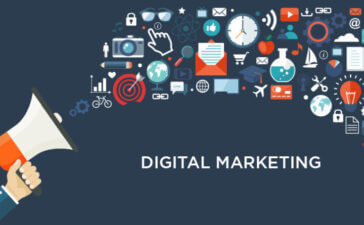People in business were scrambling to stay up with the year 2020. It was a year unlike any other, with recent events having a significant impact on digitalization trends. The pandemic had wreaked havoc on the world, and many businesses collapsed. The crisis, on the other hand, has spurred technology adoption and digitalization across industries. As a result, companies began to use disruptive technology to provide value to customers while increasing revenue and productivity.
Artificial intelligence, voice search engine optimization (VSEO), and data-driven marketing were formerly deemed far-fetched notions. However, these cutting-edge digital marketing strategies are now among the most excellent business owners’ most significant priorities for 2021. While fear of change is the most common barrier to digitalization, the transformation allows us to level up how we do business. Disruptive changes and transformational innovation are all around us. Companies must adjust to the new normal by adapting the desired changes. Digital transformation requires firms to pivot to superior user experiences centered around the needs of their customers. Companies that had most of this in place were able to keep their operations running smoothly in 2020 and even created new opportunities. They were seen as experts and assisted their workers in making the transition to virtual reality.
Let’s have a deeper look into the digitalization trend of 2021:
1) Data-Base Transitioning
Whether you’re a five-person start-up business tracking leads in Google Spreadsheets or a large corporation, maintaining thousands of data rows in Excel, or somewhere in between, data management can be a nightmare. In times when Covid-19 turned the tables, businesses had to adapt to conducting online operations. There are different database software that companies are using, for example, Airtable. Among all these database software, Airtable, like most other online database tools, provides a relational data paradigm that can organize various business tasks. If Airtable is not your thing, there also several other platforms that can be considered an efficient airtable alternative. Although, Airtable has been used by customers in various professional fields, including creative initiatives, personal productivity, customer data management, and more. This service has played a considerable role in the digitalization trends of this year.
2) Contactless Solutions
There has been a rapid transition to digital technology, which has reduced the need for direct communication, providing quicker and hassle-free service. In addition, the digital transformation movement has had a significant impact on consumer activities such as doing grocery online or other e-commerce activities. As a result, the demand for B2B eCommerce services has also increased.
3) Hybrid Cloud Culture
We have known for a while that markets are speedily moving to a hybrid cloud infrastructure. Hybrid cloud technologies allow businesses to strike the right balance for their specific cloud needs, ranging from SaaS applications and on-premise solutions to a mix of public and private clouds.
Over the last year, well-known public cloud providers have made significant investments in hybrid cloud structures. Other providers are also investing more in building solutions that make it easier to link on-premises data centers to the cloud. The purpose of these efforts is to connect with the client wherever they are.
4) Accelerated Digital & Virtual Communications
As the demand for digital services increases, 5G cellular services can meet the demand for high-speed and high-volume data connectivity. Another example of the digital revolution is the long-awaited release of Wi-Fi 6, which will enhance download speeds manifold.
We have heard about the benefits of 5G for years. Though, it wasn’t until this year that the demand for reliable connectivity and more bandwidth became a real, tangible benefit that we could all wrap our heads around.
5) Highly Focused Omni-channel Retailing
From early 2021, we had expected omnichannel retailing to become the norm, which it is now. Based on current trends, omnichannel shopping appears to be a significant determinant of success, even beyond 2021. An omnichannel supply chain has the advantage of treating online and brick-and-mortar stores as one entity. That is a crucial digital transformation trend that eliminates boundaries, resulting in un-rivaled opportunities.
6) AI Integration
Artificial Intelligence is one of the most ardent technological developments right now, and it will become an even more essential tool for interpreting and comprehending the world around us in the future. As a result, the amount of information we collect for several aspects like healthcare, infection rates, and the effectiveness of infection-
prevention strategies will continue to grow.
Understanding the changing patterns of client behavior is always a challenge for businesses. More human activity will occur online, from shopping and socializing to virtual working environments, meetings, and recruitment. It can be anticipated that the tools we use to study these behavioral changes or patterns, like AI, will advance in 2021.
7) Cloud Technologies
Another essential digital transformation subject for 2021 is the growing interest in cloud computing. Cloud computing frees enterprises from old software and provides worldwide access, which is critical for remote work. Furthermore, cloud technology offers unprecedented flexibility and mobility, allowing users to respond quickly to new
opportunities and difficulties.
8) Personalized Advanced Designing
The future is personalized, and all the companies have to adapt to this trend to remain in the court. In 2021, personalization continues to be one of the most prominent UX trends. The primary purpose of customized design is to make the user feel as if the material was developed just for them, increasing the conversion rate, which every
business wants.
Conclusion
Throughout 2020, businesses faced extraordinary uncertainty and instability, resulting in technological investments to get back to near-normal or sustain some stability level. To make their firms more robust in 2021, they’ll need to accomplish the “basic” things more efficiently by adapting technological business ideas and new trends. So, incorporating the new normal into the digital business transformations is the first step to take. That concludes our detailed guide to the most important digitalization trends to adapt to in 2021. To obtain an advantage over your competitor, you must continuously look forward to embracing new technology, techniques, and trends in your industry.




